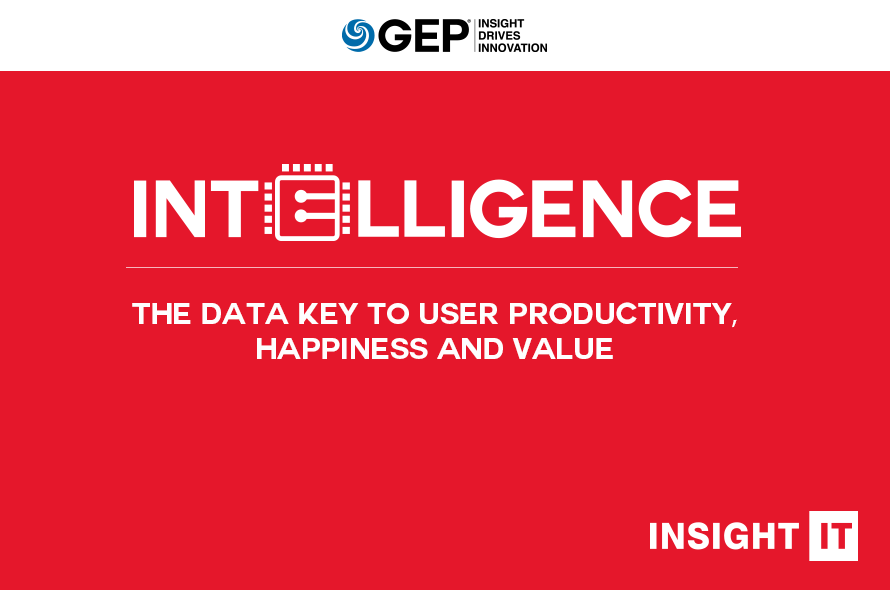Ever hear of a “trifecta”? In horse racing, it’s a chance to win big by betting on the top three finishers in a race. Today’s CIOs are in pursuit of the big payoff that comes with the “trifecta” of user happiness, productivity and value.
The “consumerization” of B2B platforms and the emergence of a more tech-savvy workforce have encroached on IT’s traditional contributions to the enterprise. To hit their trifecta, CIOs have to change up some of their priorities in favor of boosting user satisfaction and output through digital transformation. And they also have to recognize the digital transformation key: data – actionable data that can connect teams, simplify processes and deliver all-round value.
“Intelligence: The Data Key to User Productivity, Happiness and Value” – our latest addition to GEP’s Insight IT series – discusses the influence of data and connectivity in digital transformation. By focusing on delivering data – and subsequently, business insight – IT can reinvent itself as well as the impact of technology on the strategic direction of the enterprise.
Enterprise technology platforms are not what they used to be. And as their role changes, so do the expectations and reactions of the people that use them. And so, correspondingly, does the environment in which CIOs are working to advance business objectives and track the applied value of technology.

At one time, providing access to digital tools and solutions was enough of a challenge that its accomplishment counted as creating value. Now, however, most enterprise systems can be implemented in short order and are largely hosted and maintained off site. The 'consumerization' of B2B platform user interfaces has significantly reduced the need for training and troubleshooting. There's also the advent of the tech-native millennials, who represent a steadily increasing percentage of the modern workforce, bringing with them their expectations for tech immersion and general platform fluency.
But this progress does not mean the CIO's job is 'done': far from it. Today's enterprise users' insatiable need for actionable data is more than enough to keep the entire IT organization running at full speed. Technology strategy development has moved beyond uptime and compatibility and now resides in alignment with central business objectives.
For CIOs looking to hit the 'trifecta' of user productivity, happiness, and value, it's data and connectivity – not basic functionality – that holds the greatest potential for business transformation. The opportunity for IT organizations is to serve as translators: helping cross-functional teams turn data into competitive advantage.
 Productivity
Productivity

Technology that increases data awareness and visibility presents a productive and fulfilling opportunity for IT to engage with enterprise user groups. In fact, given the number of data-centric projects that cross functional silos, IT might just as well consider themselves in the 'inter-departmental relations' business.
Facilitating improved process efficiencies across different areas of the operation by providing a platform or portal as a collaborative space can increase the productivity of all groups involved in the source-to-pay process.
 Happiness
Happiness

Satisfaction with a user interface or a system's performance demands a complex balance of simplicity and depth. Technology must provide a range of controls and access – but not too much. Requirements and expectations are subjective, often forcing IT to satisfy one group at the expense of another. The one challenge all users can agree on, however, is the scarcity of time.
Platforms must support decision-making without sidetracking project timelines or forcing the team to bend their thought process to match an arbitrary system flow or data structure. By facilitating access to clean, responsive data that is both reportable and shareable, IT can increase overall satisfaction on an accelerated path to results.
 Value
Value

If the value of technology is measured in the access to and management of data, then the value of IT is reflected in what's actually accomplished with that data. When the business is not limited to simply bringing spend under management, but can actually influence spend and suppliers, it has delivered a more impactful, sustainable level of value – one that will not escape notice. The elevation of data- centric user engagement and increased collaboration with business stakeholders and executives increases the applied value of data in alignment with established business objectives.
Today's enterprise technology creates an interesting challenge for CIOs. Their role is not confined, which creates opportunities for broad influence and corporate impact. On the other hand, a lack of confinement may, at times, feel like a lack of direction. By focusing on delivering the most valuable ingredients for digital transformation – data, and subsequently business insight – rather than simply maintaining the conduit for that ingredient, IT can reinvent itself as well as the impact technology has on the strategic direction of the enterprise
GEP SMART is the most innovative source-to-pay procurement software on the market.
- GEP SMART leverages artificial intelligence and big data analytics to streamline and automate processes, speed work flows, improve user productivity and enhance user experience.
- Intuitive design, amazing visual appeal, intelligent interfaces, and the ability to work on any platform and any device, all create happy, satisfied users and drive adoption rates that are among the highest in the industry.
- GEP SMART incorporates specialized business process knowledge – in this case, sourcing and procurement expertise – to meet the precise requirements of different user types and drive value for the business.

